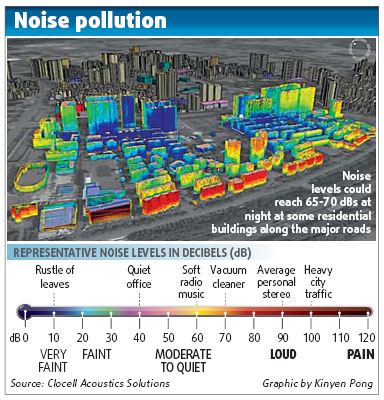
|
CHINA> Regional
 |
|
Noise map helps locate a land of peace
By Chen Hong (China Daily)
Updated: 2009-07-30 07:37 SHENZHEN: After taking a look at the "noise map" of Shenzhen, most residents would love to live in a purple haze. According to the map, which uses colors to denote noise levels in different parts of the city, purple reflects the quietest neighborhood, and bodes well for spending a relaxing night at home. The "red light" areas, on the other hand, are to be avoided. "I wouldn't have bought my apartment across from an industrial park if I'd had access to such a map," said Cong Rong, a manager at a hi-tech company. "We have been suffering from high noise levels at night for years."
 In fact, about three-quarters of complaints from Shenzhen residents about pollution concern noise, far higher than for water, air and solid waste, said Liu Tao, executive director of Clocell Acoustics Solutions, the Chinese company that developed the program. "Currently, the local government tackles the noise problem mainly by depending on complaints from residents about the issue," Liu said. "The noise map is able to visually display the noise problem in the city, which the authorities can then use to take effective measures or make long-term strategies to reduce the noise," Liu said.
The data is remotely sent to a computerized analysis center for real-time updates of noise pollution, Liu said. The results are translated into colored indicators, of which red represents the worst level - louder than 75 dBs - and purple the best - lower than 40 dBs. Forty dBs is equivalent to a very quiet residence, while 70 dBs is like the sound of a vacuum cleaner. Based on initial work, the company found that more than 200,000 residents in the area were exposed to high levels of noise. "The noise could reach 65 to 70 dBs at night at some residential buildings along the major roads, which is 10-15 dBs higher than the national standard," Liu told China Daily. About 8.7 million people live in Shenzhen, which covers nearly 2,000 sq km, official figures show. Liu said the company is in talks with the local environmental protection bureau and, if agreements are reached, the noise map could cover the entire city. Measures to curb the noise could then include limiting the number of vehicles, reducing speed limits, adopting better materials for road construction, and implementing methods to lower the noise such as green belts or sound barriers, he said. |